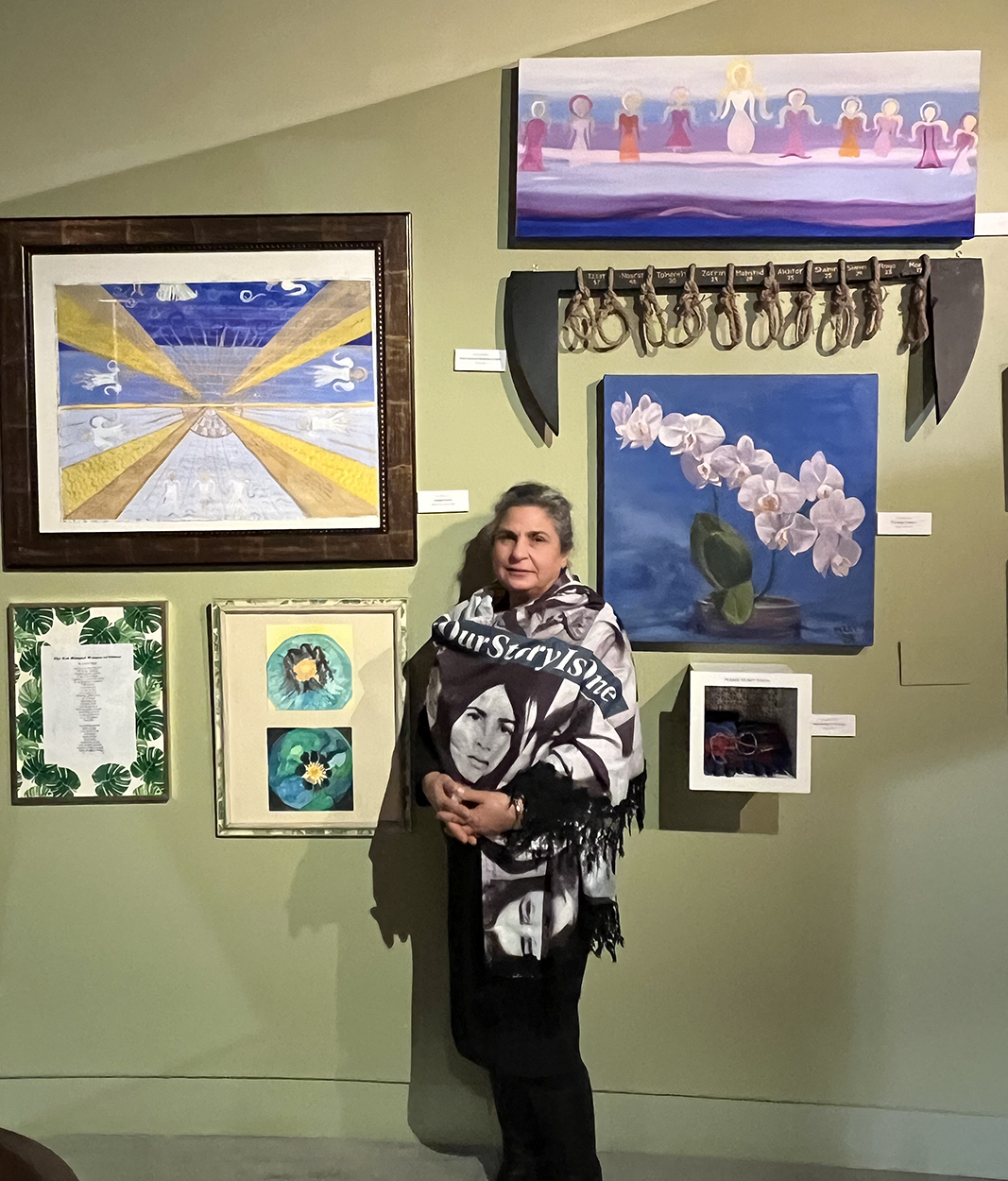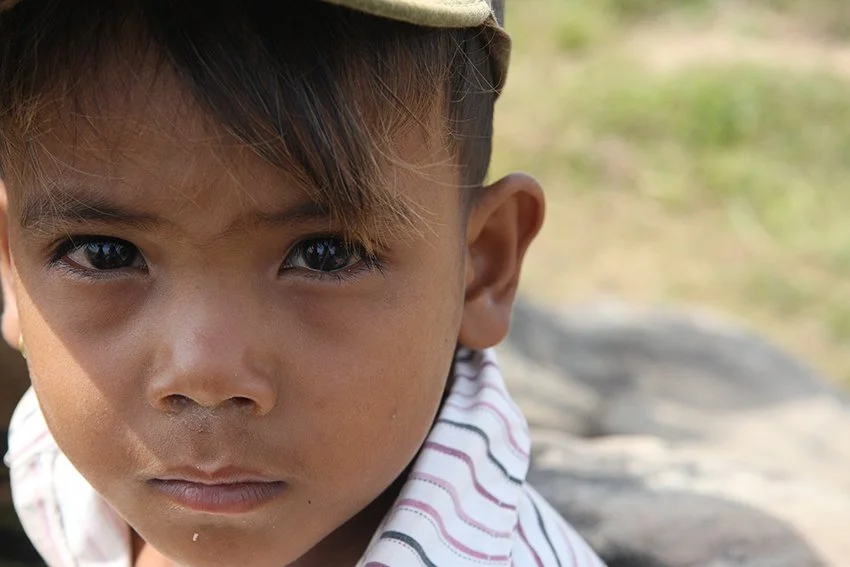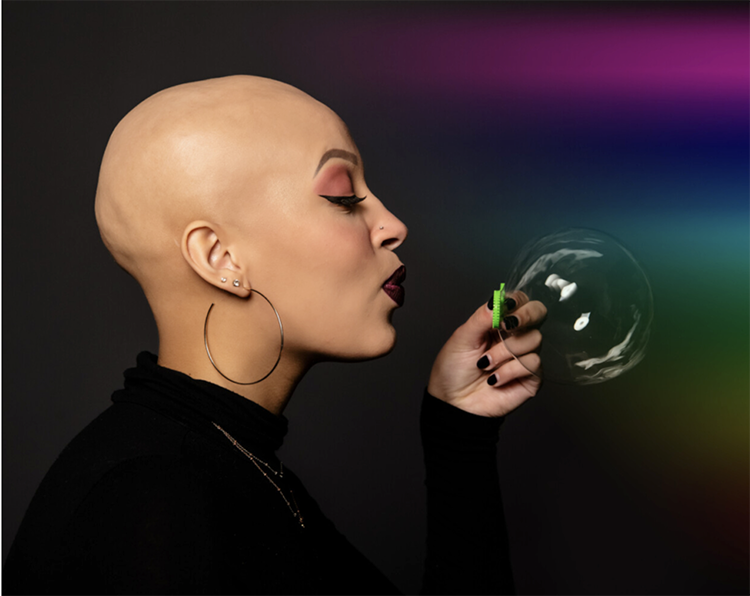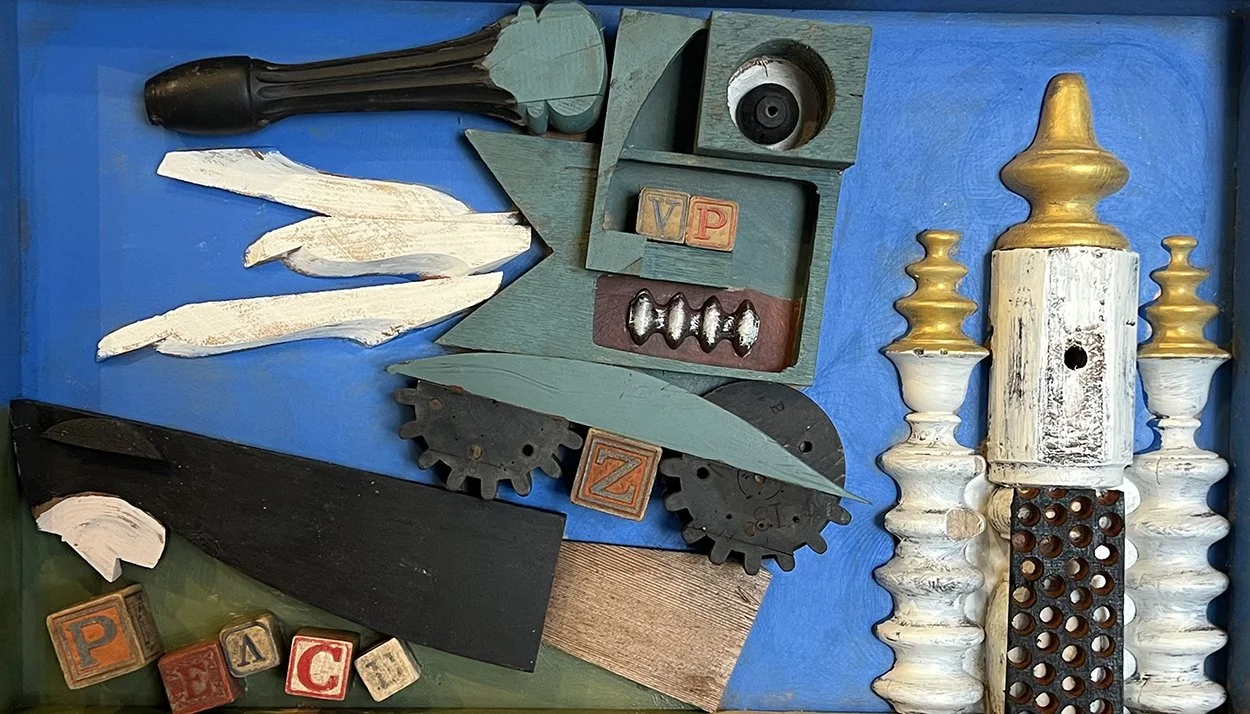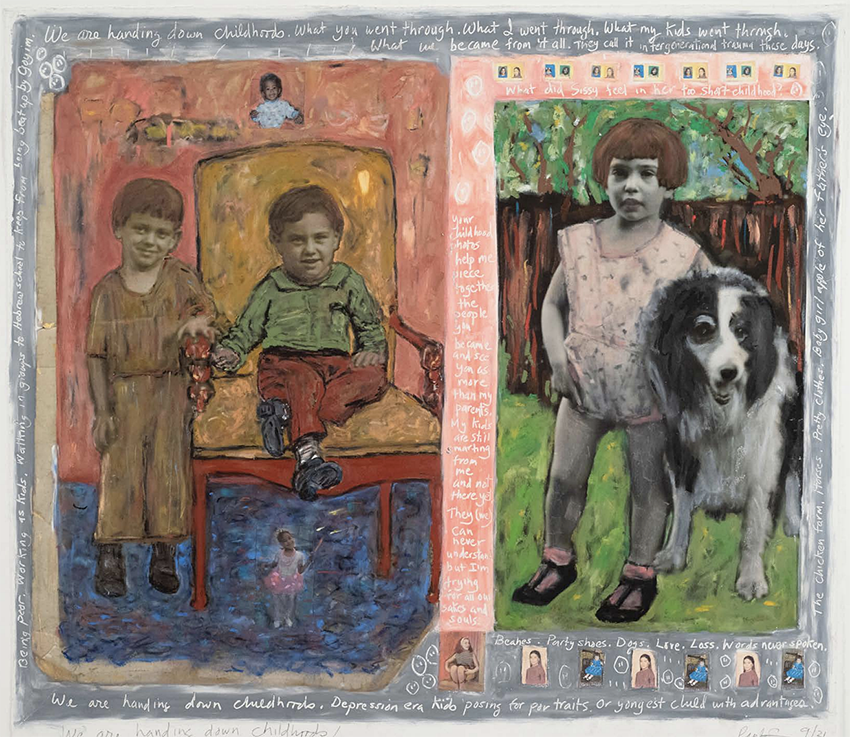Recent Exhibits
The Ravensbrück Series
The Ravensbrück Series by the late Brenda Bettinson is a collection of 17 paintings created with acrylic paint and pencil on board, panel and fabric. Brenda was moved to create the works after she read Sarah Helm’s book, Ravensbrück: Life and Death in Hitler's Concentration Camp for Women about the enslavement, beatings, torture, rape, starvation, surgical experimentation and murder of the women at the concentration camp. The Ravensbrück Series will be exhibited at the HHRC from June 12th to September 19th, 2025.
Reuse, Repair, Reconsider
Maine Artist Lesia Sochor’s Reuse, Repair, Reconsider Series is now on display in the Michael Klahr Center. The artwork explores the healing power of restoration and repair. She writes, "A humble act born of necessity, repair at one time was a common sense, commonplace task among the populace. The ever increasing consumer driven addiction for more, for new, and newer, adequate and fixable goods are simply discarded contributing to our threatened environment. I use a needle and thread as a representation to investigate mending as an intervention, as metaphor, as a call to action. Not only to restore material things, but as an intention to mend the fractured parts of ourselves, the divisiveness, cruelty, and injustices of our ruptured world one stitch at a time." Lesia has been a generous collaborator and friend to the HHRC community. She loaned us her Babushka and Pysanky paintings to grace the walls of the Michael Klahr Center, and will, for the third year, offer the popular Pysanky egg decorating workshop in the spring. Lesia is a prolific, imaginative, thoughtful artist delightful women. Thank you Lesia!
#OurStoryIsOne
#OurStoryIsOne is a global art movement that commemorates ten Baha’i women who were killed for their religious identity. This is also a personal story for Maine resident, local activist, and artist Parivash Rohani. Striking, bold artwork from around the world is expressed and shared through social media, especially on Instagram, as courageous people share their pain, protest, and courage through creativity. On 18 June 1983–41 years ago–10 Bahá’í women were taken to a square in Shiraz, Iran, under the cloak of night. After months of torture and imprisonment, they were mass executed without the knowledge of their families. One was 17, most in their 20s. Their crime was their belief in a faith that promoted gender equality, absent and criminalized in Iran, justice and truthfulness. They were hanged one by one, each forced to watch the next woman’s death in a harrowing attempt to coerce them into renouncing heir faith. None did. Today, in the blood, tears and wounds of thousands of young women in Iran fighting for equality, one can see the legacy of the 10 women of Shiraz. Though mistreated and imprisoned, today’s women—just like those before them—are bravely sacrificing to live in a more prosperous Iran. Learn more about Parivash and Nasser Rohani and their fight for justice and equality in Iran and around the world.
Child of War
Chanthu's paintings and sculpture are arresting. Her use of metal and ceramic sculpture and paintings depict the emotions she experienced as her family’s lone survivor of the Khmer Rouge regime in Cambodia. Many contain images of war and disruption, while others touch on selfhood, freedom, abstraction. On her website she writes, "Not only can art connect us to our various identities, heritages, and cultures, but it enriches our respect and appreciation for the world around us."
Rethinking Place
For her debut photographic exhibition, Mardi Millay traveled to her birth culture and country of Cambodia and neighboring Southeast Asia. She engages with her subjects to reflect and capture a sense of home—be it a physical place, a feeling or chosen community. Using this expanded definition of place, Mardi explores identity through her adoptive family and relationships with an underexposed perspective. Her portraits suggest so many emotions, compelling one to wonder about a child, woman, elder's life and the stories behind their complex expressions.
The two exhibits were made possible from a collaboration with Khmer Maine, and our friend and former HHRC colleague, Marpheen Chann. They opened on Monday, May 20th in recognition of Cambodia National Day of Remembrance, which commemorates the victims of the genocide in Cambodia that took place between 1975 and 1979
Babushka Paintings
We were honored to display the gorgeous Babushka Paintings created by Lesia Sochor in the Michael Klahr Center. Lesia writes, "Love of my ancestral homeland and horror at the merciless, brutal unprovoked invasion of Ukraine compelled me to paint images of Babushkas. This iconic symbol of a culture stirs memories of my mother, who in her later years wore one most every day. The images plead to have peace and freedom in their beloved country. A beleaguered nation that has endured a traumatic history, but one which, since 1992, has embraced democracy and independence. A nation which was building on the principles of political, social and religious freedoms. A nation who wanted to pursue peace, who gave up its nuclear weapons. A nation wanting to steer its own course with dignity. A nation with a president who cares for his people; for making Ukraine productive, prosperous and progressive. A nation rich in culture and traditions. A nation of joyous hard working people.
I am filled with pride at being Ukrainian. I am thankful to my immigrant refugee parents, who in the Philadelphia diaspora, continued the language and traditions which I have carried on with my own children. I am reliving their stories as I listen and watch the dreadful devastation of an unsuspecting country. I condemn this war, I condemn the man behind it. The unthinkable is happening and my heart breaks. Slava Ykraina."
29 Mainers
The 29 Mainers exhibit was created by Portrait Photographer Erin Moore, owner of Mercy Street Studio. Moore’s 29 beautifully rendered portraits draw you into a narrative. Each canvass also stands on its own as a work of gorgeous art, depicting a moment, a story, an identity or close relationship as she explores the complex richness of race and cultural identity in its many forms. Moore says the 29 Mainers project was birthed out of the desire to add Black faces to the world of fine art portraiture. Defying stereotypes and bias, Moore presents Black men as loving, fatherly, scholarly, loyal, and successful and Black women as devoted, passionate, intellectual, commanding, and powerful. Named Maine's 2018 Portrait Photographer of the Year, Erin's photographic style is modern and fun with the goal of capturing the inner spirit and beauty of each person she photographs. She is passionate about using her camera to show people how beautiful they are. Erin's inspiration for 29 Mainers came in part from a desire to add Black faces to the world of fine art portraiture.
Says Executive Director Tam Huynh: “I love bringing exhibits into our beautiful space. It takes thought, time, conversation, collaboration, and work to go from concept to ready for viewing—and I enjoy the whole process. It's a pleasure to discover local artists and enjoy time with them, often visiting their studios for a chat. Discussions around which pieces to include, where and how they should be displayed and appreciated is all part of the process. And then comes decisions around space and placement, and carefully hanging each piece. When it is finally ready and open, I'm always thrilled; I just can't wait to share it. I feel this strongly about our new exhibit, 29 Mainers. It is spectacular. Impossible to adequately describe, these 29 stunning, moving, beautifully rendered portraits draw you in. Each stands on its own as a work of art, depicting a moment that suggests a story, an emotion or relationship. They leave you mesmerized, intrigued, wanting to know more. Simply put: you must come and experience this exhibit.”
Artists Response to Ukraine
The recent exhibit entitled Artists Response to Ukraine featured three Maine artists’ responses to the Ukrainian war. André Benoit creates wood assemblage out of objects he discovers on his daily walks or gifts from friends. Last year he composed abstract scenes and images of the war-torn country that are beautiful and poignant. A second Maine-based artist, Lesia Sochor, is a painter who practices the ancient ritual of transforming an ordinary egg into Pysanky—a cherished Easter tradition of egg decorating that dates back to 5,000 BC. Photographs from Ukrainians citizens, collected by Maine Jewish Museum Curator of Photography Nanci Kahn, reveal everyday life during the war. Some of them show ordinary places and interactions; others chronicle destruction and grief. We were so fortunate to have all of these pieces showcased in the Michael Klahr Center for six months. The wood ensemblages are still in the Center for visitors to see.
Generational Layers
The amazing Generational Layers exhibit by Paula Gerstenblatt filled the gallery room at the Michael Klahr Center. The artwork uses photographs, paint, and handwritten text to explore the layers of nationality, race, and religion that comprise Paula’s family history. The collage paintings weave individual experiences into a collective narrative of Jewish immigration in the early 1900s—from Czarist Russian Ukraine and the Austro-Hungarian Empire, through the Great Depression, two world wars, Jewish South Beach in the 1950s, the artists coming of age in the 1960s-70s, to the present times as the mother of two adult Black/Jewish children. The works are gorgeous, complex and evocative.
Reflections on Genocide
We were thrilled to display striking works of art created by Casco Bay High School students. Leslie Appelbaum and Matt Bernstein, teachers at Casco Bay High School, learned that students were no longer studying the Holocaust. Believing that education alone can render students feeling helpless, they wanted them to experience how art can be a tool of peaceful empowerment. So they developed a course, “Art and Genocide: A Case Study of the Holocaust” to inform students about how the Holocaust was allowed to happen and to understand both the perpetrators and the heroic efforts of those fighting against it. Secondly, they wove in art to illustrate how individuals at the time protested, and how artists so often create powerful forms of activism. The student projects are memorials to relatives and protests against attacks against members of any community. They expresses how audacious hope can be, evoking the horror in every act of genocide and the powerful forces that fight against hatred with love. We are honored to have been gifted the pieces into our permanent collection, where they will be displayed throughout the Michael Klahr Center.


